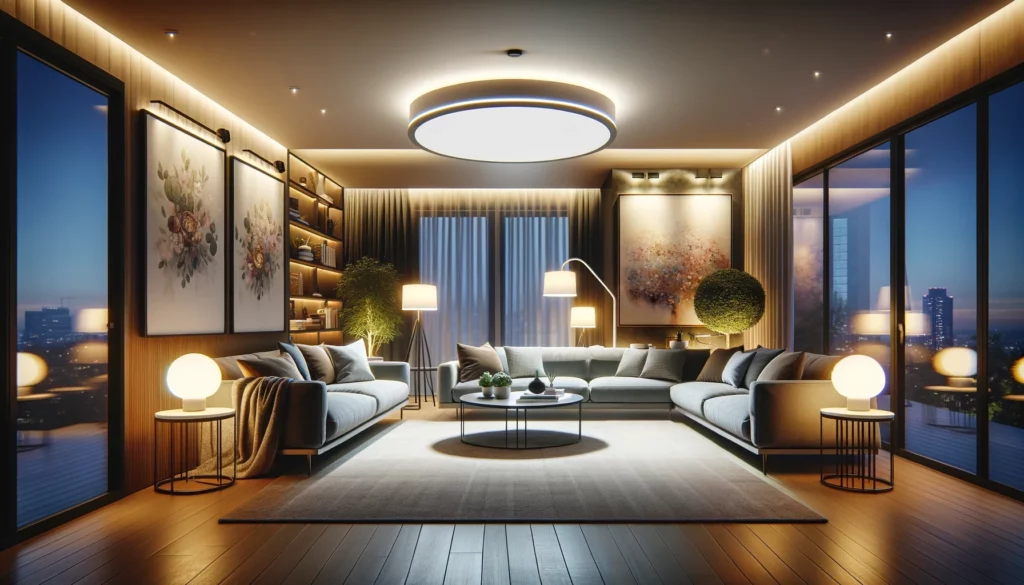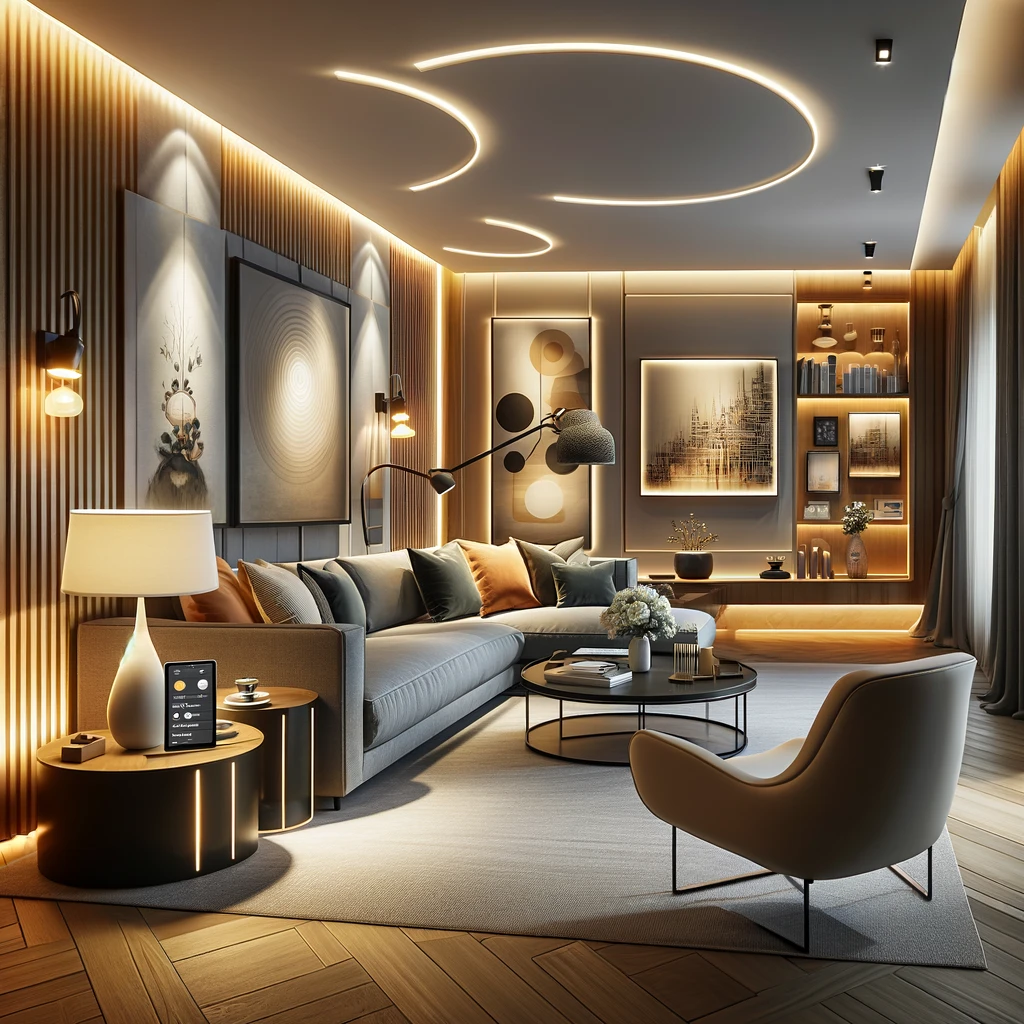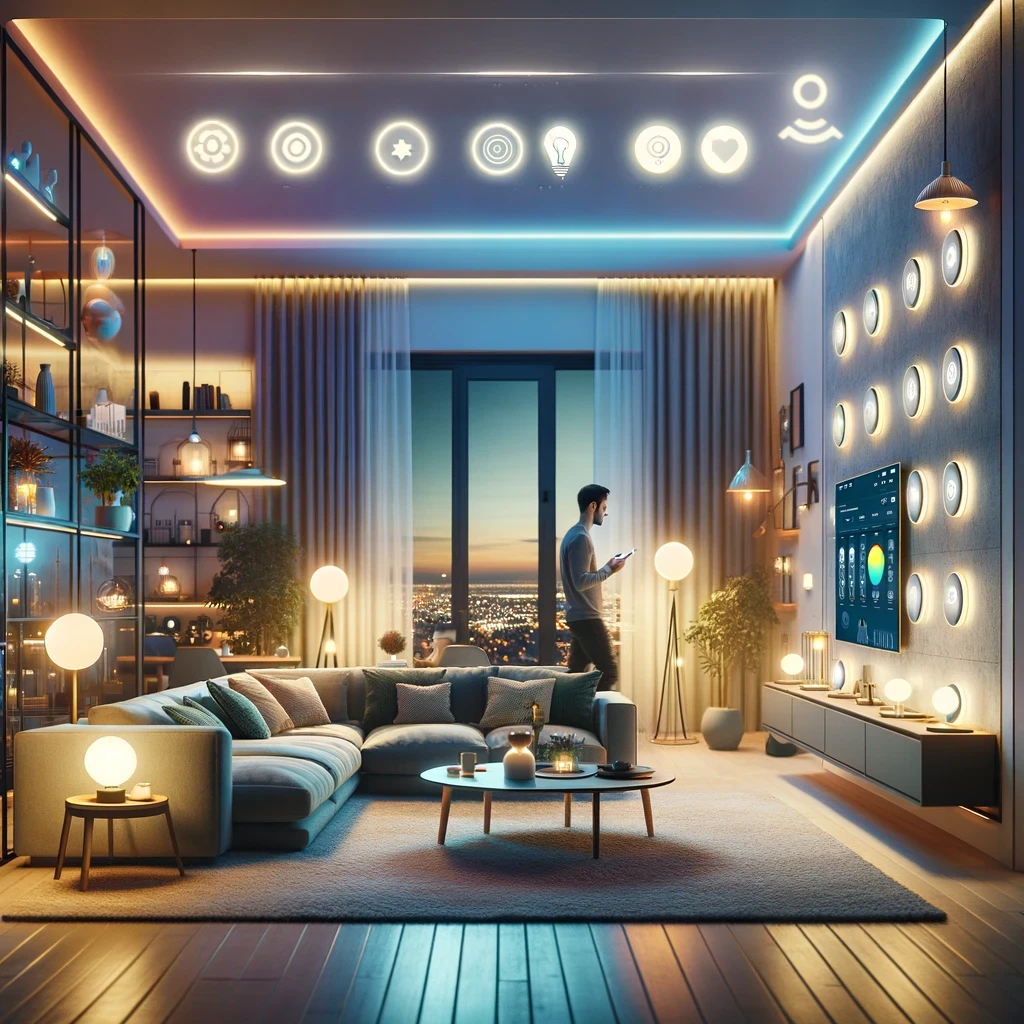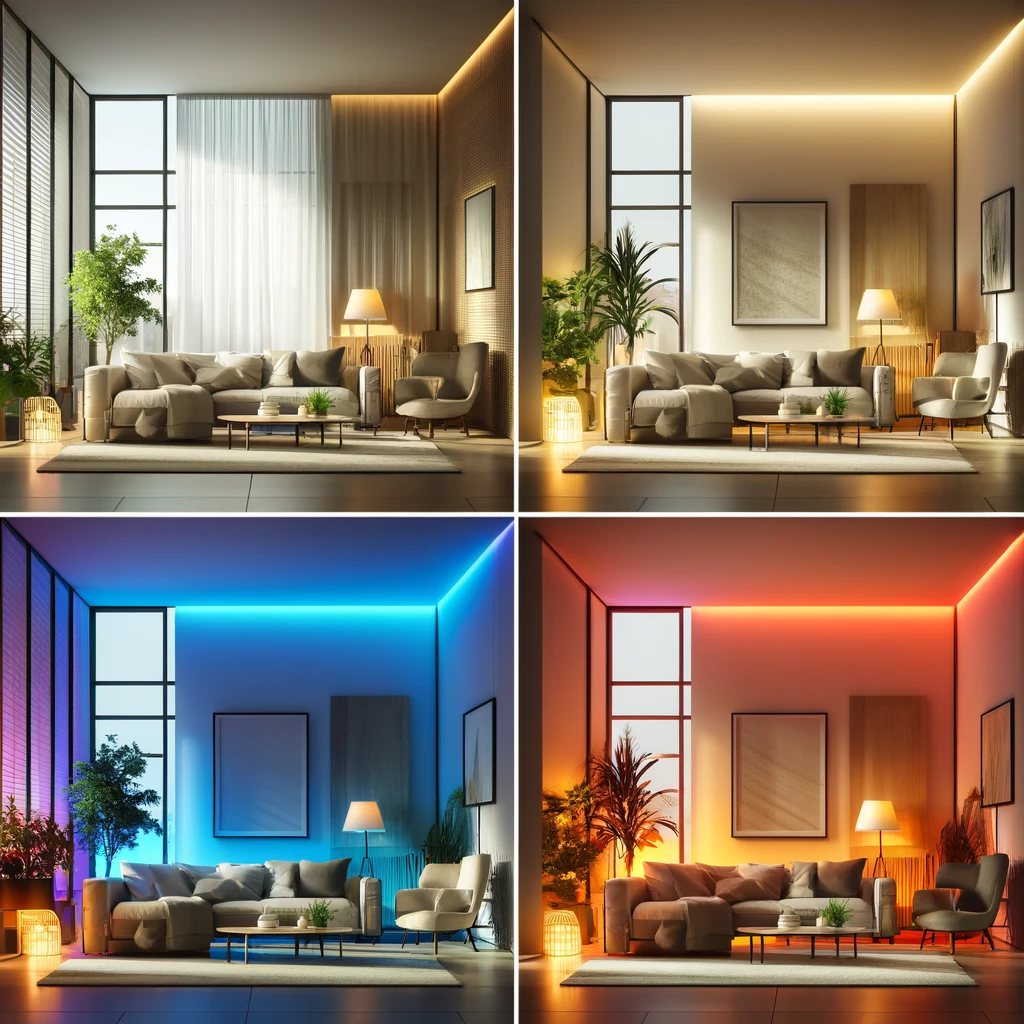Tips for Effective Home Lighting: A Transformation in Space
It’s like walking into a room that is bathed in warm, friendly light. The air is warm, the furniture shimmers and you feel instantly chilled out. How about entering a space only lit by bright overhead lighting? The ambiance seems cold and forced, which makes you want to Immediately rush out of the area And that, people, is the magic of lighting — it has the power to make over your home from mud-run course to ballroom in an instant!
Exceptional home lighting is more than just being able to see; it’s an experience. It creates ambiance, demarcates your design statement and provides you with spaces that are as boilerplate as feasible. From making a small space feel larger to focusing attention on great artwork, lighting can also set the mood and energy of your home.
To realize the highest level of illumination in a home, it’s important to distinguish between types of lighting and what their purpose is within each room (function).
- Ambient lighting is the general illumination of a room that provides overall daylight. Take a chandelier, ceiling light or even good floor lamp as bien. Thus, it establishes an overall mood and vibe for the place
- A type of light used for task focused activities. For example, reading or task lights which can be placed next to a sofa make using the sprawling shelf for a staked book collection a spot to lean into some good literature. Task lighting — lamps with moveable arms over the couch back, under-cabinet lights below shelving or even a pendant light above your kitchen island — are all part of this fundamental lighting design principle. It revolves around task lighting.
- Accent lighting is used to highlight certain features and add intrigue to your home…. or accent, spots that might involve a wall sconce highlighting an oil painting i.e., track lights spotlighting sculptures or even a spot light directed towards architectural features. Layer accent lighting for dimension and contrast in your space.
Now that you have an idea about the different types of lighting, and what they can add to a home its time to design with light! The right kind can take any room from dreary and dark to warm and inviting (perfect lighting in the kitchen can turn you into a master chef!)
For detailed information about lighting, don’t miss our Home Improvement Lighting Tips: Brighten Up Your Life with Powerful Results
The Language of Light: Essential Aspects for Home Lighting
But it is those basic principles that define good lighting that should guide you before you even start to pick out fixtures and bulbs. Is info will help you make informed decisions that ensure your lights are as beautiful, How to choose the Best Led light and at times functional.
Color Temperature (The warm of the Light)
Color temperature is the name given to the characteristic of visible light that determines whether like appears warm or cool and it shown in units of absolute temperature, K (Kelvin). Let me give you a summary of the color temperature and its impact.
Soft white (2700-3000K): It warms a space to make it cozier and more intimate. For living rooms, bedrooms & dining spaces where something comfortable and welcoming is required.
Cool white (3500-4500K): Also favored for kitchens, bathrooms and home offices because of its crispness and focus ideal in those settings.
Daylight (5000-6500K): This bright, white light mimics natural daylight and is a good option when it comes to illuminating the home office or other areas with little natural light. It is typically installed in home offices and workshops where crisp viewing is a must.
Lumens: Measuring Brightness
Lumens show the amount of light produced by a bulb. It is a much better and more practical measure of light compared to watts which is actually the amount of energy. More lumen output means brighter light.
General Guide to Lumen Requirements by Area
- Living room: 1500-2500 lumens
- Bedroom: 1000-1500 lumens
- Kitchen: 2500-4000 lumens
- Bathroom: 1500-2000 lumens
- Home office: 2000-3000 lumens
Dimmers: Controlling the Mood
Dimmer switches are one of the least expensive features that you can put in your home that will have a really dramatic impact and change its appeal. They give you control over the brightness of your lights to help you set a mood anywhere from bright and energetic to soft and intimate. In addition to this, dimmers save you energy which helps lower your electric bill and prolong the life of your bulbs.
Selecting the Proper Fixture: Design and Function
The right fixture is important for beauty as well as functionality and there are plenty of styles to choose from — including classic chandeliers, industrial pendants, and contemporary track lighting. Consider these factors:
- Style: Choose fixtures that suit your design-home.
- This then results in the following rule: Size — pick fixtures that are suitable both for the room and for any tasks to be done there. For instance, a grand chandelier would be out of place in a petite dining room, but might seem lost in the void of an expansive living room and an impossibly tiny pendant light could disappear on vast high ceilings; you get the idea.
- Type 0f Working: At First you should look at what the purpose of fixture is. A desk light, for example would need to be adjustable and directional whereas a chandelier in the living room might only serve to create ambiance.
With this knowledge in your back pocket, you will now be able to choose the correct bulbs, fixtures and technique of lighting for a complete makeover of your home. Beginning with the effective layering of lighting dispensing better functional and adaptive environments. With that introduction, Baselights will now go into its next topic explaining how to achieve results required.
Layered Lighting for a Multi-Dimensional Home
Picture you had one light in the middle of your room and it’s supposed to provide all the light needed for that particular space. So, it may be bright enough yet flat so to speak and one-dimensional and not suitable for different events. Consider instead a layered lighting plan — ambient light for general welcoming illumination,task lighting to read, and accent lighting that highlights your favorite artwork. A well-lit house transforms into a multi-dimensional home with this layered approach.
BEFORE: Ambient Light Setting the Scene
Ambient lighting forms the base of your home’s overall light plan. It offers ambient lighting across the entire room creating a general mood and atmosphere It is like having the gentle low level light in the house that creates the calm, warm atmosphere in which we live.
opular Examples of Ambient Light
- Chandeliers: As the most visual light source fixtures, many chandeliers create focal points in dining rooms (directly over the table), foyers (suspended above you as you enter through the door) adding a sense of elegance and grandeur ago. They create one point of focus and are dimmable for a more cozy mood.
- Ceiling: This lighting fixture provides the illumination for the entire of your room, whether it is a flush-mounted or suspended. They may be as simple or detailed as your design palate requires.
- Common Lighting Floor Lamps: Floor lamps are a fantastic way to add ambient lighting and become proficient in many spaces. The colors produced by these lights can create pleasing effects to match your décor and also they can be set to pretty low levels creating a cozy tones.
- Wall sconces: Sconces give you that ambient light next your wall and add some visual interest to the plain walls seen here.
Task lighting: Lighting for your lifestyle
Task lighting illuminates a particular activity to prevent partial blindness and reduce eyestrain. It is like a spotlight that allows you to cook in the kitchen, read on your favorite armchair, or work at your desk
So, let us quickly check some basic types of task lighting.
- Lamps and desk lamps: Available as adjustable fixtures, they work best in home offices; studies or even by your bedside for focused lighting when you need to read, write or do some paperwork.
- Under-cabinet lighting: This task-specific luminaire is perfect for brightening up your kitchen workspace and ensuring that you can prepare food, clean dishes, or find what’s hiding in dark bottom cabinets.
- Pendants: Pendants can be used over focal points in your kitchen as task lighting. For instance, a pendant hung above an island not only offers task lighting for meal prep but also acts as the visual centerpiece of the room.
- Track lighting:Track light systems are the best task lights, which you can aim anywhere and use it in kitchens and workstations or even inside art galleries.
Accent Lighting for Dimension and Drama
Finishing Beauty Accent lighting is a way to add drama and visual interest to your home. This trick is overall about drawing the viewers eyes to a certain detail, make them feel as if they can see through layers of your application and emphasize your design in other words. This is like the accent lighting that makes your favorite artwork pop, or highlights a beautiful architectural detail in your home or even becomes a dramatic focal point of the living room.
Some of the most popular accent lighting ones are:
- Sconces: Wall sconces are great for providing general light and highlighting artwork or other important spots you want to bring attention.
- Recessed lights: When installed in soffits or beams, recessed lights can accentuate architectural features and provide depth illumination for modern homes.
- Track lighting: A flexible way to send light exactly where you want it — on artwork, sculptures or the cool architectural elements some people have in their houses.
- Uplighting: uplighting is a technique that illuminates plants, sculptures or architectural elements from the ground and can create great effects.
By layering lighting you create a multifaceted and utilitarian lighting design which both visually magnifies your space as well helps it make more efficient. Every layer has a unique character which plays an important role in determining the overall look of your space.
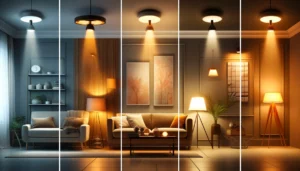
Capturing Natural Light: A Brighter, Greener Home
Natural light is the most important part of our home, providing more warmth and enhancing energy to ensure an inherent sense of elegance. This is an eco-friendly option, allowing you to lower your dependability on artificial light, and reduce energy use. Optimal use of natural light in the different spaces inside your home will make it brighter, welcoming and eco-friendly.
Balancing Light & Privacy with Window Treatments
Window treatments are essential for managing natural light and offering privacy. Pick window treatments that give you privacy at night but let natural light flood the room during the day.
- Sheer curtains: these are lightweight, transparent curtains that let lots of natural light filter through but at the same time keep you shielded a bit from the view. Perfect for soft, diffused light in living rooms and bedrooms.
- Blinds: Blinds allow the control of light levels to be far more accurate than a blind. This is in particular useful for kitchens and home places of work, where you want to create sure areas dark at any time.
- Basic Style: In design terms a basic style is an automatic choice. prosReal money Online casinos leaves me with more time at home to deal out its hands, forever changing design trends and occasionally dumping the once-hot shade that almost broke arms them less than two decades ago. They come in different materials and design which would complement well with your home décor.
Allowing Light to Reflect on the Walls and Space
Light: A bright light-colored wall reflects natural light and makes the whole room feel larger regardless of its size.
- White: White is the classic color that reflects all wavelengths of light, so it gives a room an airy or a fresh appeal.
- Cream: A wall color with a sense of peace, softness and warmth.
- Darker gray: heather light gray- soft and elegant new color for a modern beautiful roomännlich– Few natural offiices.
Mirrors- Reflecting light and space
Mirrors are great for reflecting light into a room, creating the illusion of space and brightness. Positive light from strategically placed mirrors help to brighten up dark corners and at the same time can give the room a feeling of depth.
- Entryways: An entryway with a mirror can reflect some of the natural light coming in from outside, which will help your entrance feel warm and more spacious.
- Sitting rooms: Mirrors situated opposite a window can actually reflect natural sunlight brightening the room and giving an impression of space.
- Mirrors are not only a necessity above sinks, but can also open up a small bathroom and make it more inviting with the correct mirrors.
Lightwells: Interior space for a breathe of light.
Lightwells: Vertical shafts in a house that reinforce the access of natural light deep within the middle bits. They are the ideal install for basements, atriums or rooms that do not have windows. Lightwells can turn a dingy, dark space into one that is bright and airy.
A Room-by-Room Guide to Lighting
With a strong foundation of lighting basics and methods under your belt, it’s time to take those principles and apply them to areas throughout the home. From one room to another different light is needed and can change the overall look and usability of your lighting design.
Functional and Stylish Kitchen Lighting
The kitchen is where the magic happens, sometimes even alchemy of form and function! Proper kitchen lighting can help to brighten up the cooking area, make the dining room a little cozier and put your decor in focus.
They define five main kitchen lighting types:
- Task Lighting: Area-specific lights, like the under-cabinet fixtures for chopping vegetables washing pots and pans. For a focused lighting option and added visual interest try pendant lights above the kitchen island.
- Ambient Lighjting: Use a combination of ceiling mount lighting and hanging lights for overall illumination throughout the kitchen. For dining, Colony chose warm white bulbs to give the space a more intimate feel.
- Accent Lighting: Use accent lighting to highlight your gorgeous backsplash, cabinetry, or other decorative features. Use recessed lights to softly accentuate structural details and track lighting to illuminate art or collections.
Living Room Lighting: Versatile Light Layers
As a space for relaxation and entertainment, the living room can play different roles. The best lighting designs for living rooms are bright fixtures that bond style, warmth and light to provide your abode with a hospitable ambiance, directed task lighting which focuses on activities such as reading or playing board games in the central table.
- Ambient Lighting: A chandelier, ceiling light or a few floor lamps can serve as source of general lighting to the living room. With the warm white bulbs you will feel as if you are indoors in coziness.
- Task Lighting: Floor lamps, and table lamps can offer close lighting for reading, working or playing games Install a dimmer switch so you can control the brightness depending on what activity is taking place.
- Accent Lighting: Highlight your artwork, sculptures or architectural detail with purposefully placed accent lighting. Add sconces, recessed lights or track lighting for an important statement.
Romantic and Relaxing Bedroom Lights
Bedroom lighting should provide a calming atmosphere, an enjoyable reading environment and it also can highlight the bedroom’s décor.
- Ambient Lighting: General light is obtained from a ceiling fixture as well or individual bedside shinny medium. Because the perfect bedroom is a warm and cozy one; go for warm white light bulbs.
- Task Lighting: Table lamp (for reading in bed) Opt for lights with movable shades so they can direct the light where needed.
- Accent Lighting: Plugging in some sconces or string lights can help to give the room a romantic feel. Opt for natural light, candlelight or soft warm lighting to make your home appear more welcoming and comfortable.
Task and Safety Lighting for the Bathroom
A bathroom needs a practical mix of lighting and an all-stops-out choosy-woosies aesthetic, to help guide the way toward greater facial-hair trimming accuracy & chemical-free Arachnid Habitat relaxation spa-style action.
- Task Lighting: Choose a mix of overhead lights and wall sconces to provide plenty of light for applying makeup and shaving.
- Ambient Lighting: Dim the lights in the bathroom during a bath, shower or relaxation time. Dimmers on an overhead light (and any still lighting you have) are all helpful at creating that spa-like quality.
- Safety Lights: Make sure your bathtub or shower has adequate lighting for increased safety. Think about getting a nightlight for when those late nights and early mornings.
Productivity and focus Home office lighting
The home office ought to be a place full of productivity and focus. Good home office lighting should be bright enough to work by, soft enough not to tire your eyes and ideally reflect a similar light quality to natural sunlight.
- Task lighting: Purchase a desk lamp with adjustable brightness, and directed shade to give focused light for work.
- Ambient Lighting: Ambient Lighting is created by a ceiling light or floor and table lamps to establish the overall lighting needs.
- Accent Lighting: Clue in on your book pediments, art, or structural highlights with emphasize lighting.
With this knowledge of what each room’s goal is, you can design stronger rooms that will fulfill your lighting needs and make a home as well. In our next section, we investigate smart lighting in the home and demonstrate just how technology can elevate your illumination.
The Future of Home Lighting: Smart Lighting
Smart lighting is one of the major steps in which we can interact with our homes, providing a somewhat unprecedented level of control, customization and convenience. From controlling your lights with your phone, setting schedules and warmer color temperatures that help you fall asleep; smart lighting takes home illumination to the next level.
- Control and convenience: imagine using an app or talking to your favorite voice assistant to turn lights on and off, dim a few levels up/down as you move through the living room or changing color temperatures. Turn off the lights in your bedroom from bed or dim the lights in your living room to watch a movie all without having to get up.
- Energy Saving: Smart lights usually provide energy-saving options, such as automatic timer and dimming features that can help you save on electricity.
- Increased Security: Program smart lights to turn on and off at your preferred times, making it look like somebody is home even when you are out. It comes with this feature to prevent intruders and to get maximum security of a house.
- Personalization and Mood Alteration: In numerous cases, the smart lights allow tuning of the color temperature and even change in light color. Choose a warm, cozy setting for an evening celebration or choose a bright day you are going to set the beat in.
Smart Lighting Options: Bulbs, Switches & Systems
Smart lights abound, and options are countless for nearly any requirements or budget
- Smart Bulbs: These connect to Wi-Fi routers and can be controlled from an app. Some popular brands of smart bulbs are Philips Hue, LIFX, Yeelight etc.
- smart switches: These replace your existing gauges and allow you to access the logic of lighting outside the home.
- Smart Lighting Systems: These work best with other smart home innovations as they provide things like automated routines and voice control. Big brands such as Lutron, Hubspace, and SmartThings
Which is the Best Smart Lighting for You?
Your quick guide when choosing a smart lighting system
- When deciding on smart bulbs, switches or systems to incorporate into your existing home here are a few things you should consider ensuring compatibility
- Features:Determine which elements are significant for you, including remote control, scheduling, dimming, colour temperature control and voice integration.
- Price : Smart lighting options are available at a wide range of price points, so come up with how much money you’re willing to spend and see what’s out there that fits your budget.
Smart lighting, on the other hand, is taking your home or office illumination to a whole new level of control, comfort and energy efficiency. With the advancement in technology, we can only foresee more ground-breaking and highly intelligent smart lighting solutions to grace our presence.
Frequently Asked Questions About Effective Home Lighting
How to know which Is the ideal household light pertains for you?
There are two main things you must consider when choosing the best light bulbs for your home; Color Temperature and Lumens Color temperature is how warm or cool the light looks, and it is measured in Kelvin (K). For example, warm white(2700-3000K) is suitable for places of cozy nature whereas cool white (3500-4500K) is nice to have around task oriented spots. Lumens account for all of the light output and more lumens means brighter. Check the article for a lumen guide that will help you figure out how bright lumens should be in each room.
Why Should You Go with Dimmers?
Benefits of dimmers: they permit you to control the brightness in your home (for various moods/atmospheres). This is great when you’re trying to create a warm and relaxing atmosphere or simply improve the mood for something more romantic. Dimmers are also great for the obvious reason that they consume less energy saving you bulb life and lessening electricity usage.
How To Use Natural Light In Your Home??
Here are some of the things that you can do to maximize natural light: Window treatments: Opt for sheer window curtains or blinds which will allow lighting filtering and retain your privacy. 1) Light colored walls and furniture: Reflects natural light makes it look more open and bright. Mirrors: Mirrors can bounce light around to make the room look bigger and lighter.
